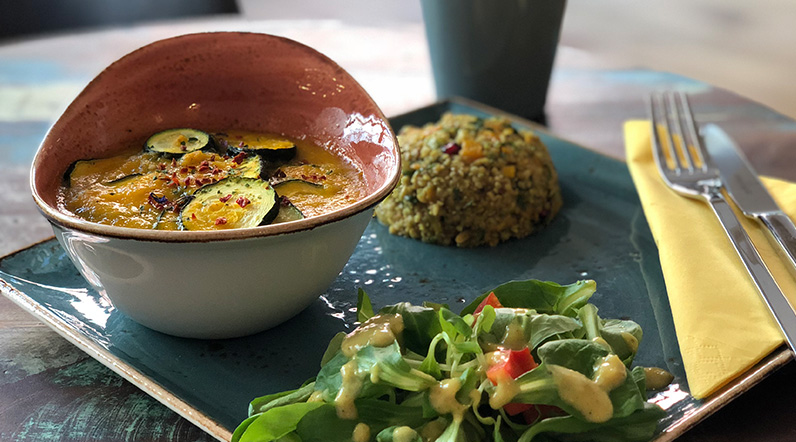Ayurveda Health Coach
For all those who want to understand Ayurveda in its depth: Comprehensive training with 4 modules and a certificate as Ayurveda Health Coach.
Ayurveda, the traditional medicine of India, includes a complete nutritional system. It is based on the fact that the food is individually composed and well tolerated. In this way, food gives not only valuable vital energy, but also physical health, emotional satisfaction and clarity of thought. At the same time, Ayurvedic food with its rich palette of flavors is a delight for the senses. Ayurvedic diet combines effective nutritional therapy with creative cooking. Fresh foods are selected to suit the constitutional type as well as the time of day and season, and are thus geared to the individual metabolism. A wide variety of herbs and spices not only give the dishes a wonderful taste, but also influence their compatibility and effect on the person. With a great sense for the intelligent use of all the treasures of nature, an Ayurvedic menu takes into account the physical and mental needs of the individual and promotes a healthy lifestyle.
Ayurveda knows some basic nutritional principles that apply to all people, regardless of individual constitution and metabolism. They help to rebalance the doshas again and again and to optimize digestion. Integrating the following nutritional rules into daily life can increase personal performance and promote health. They are also suitable as a guideline for a nutritional therapeutic diet.
Too much food can lead to disorders just as much as too too little. So eat in moderation! A rule of thumb is to divide the volume of your stomach into four parts. One part is for liquid food (e.g. soups or drinks) and two drinks) and two parts are "reserved" for solid food. The remaining fourth part should be left empty to optimally support the digestive functions optimally.
Choose warm meals, preferably home-cooked. Hot meals stimulate the metabolism and digestion, so at least digestion, so at least lunch and dinner should be prepared warm. dinner should be prepared hot. In this way digestible foods can be broken down and utilized better. can be better utilized.
High-quality, fresh and prepared with love - that's what pure food looks like. Eat products that are as little as possible with pollutants, insecticides, fertilizers or preservatives. preservatives as possible. The grow your own vegetables in the garden and shop in organic organic food stores. Choose foods that are local and in season. and are in season.
Let yourself be guided by your individual food preferences and tolerances, i.e. your constitution (prakrti) and your current as well as your current health complaints (vikrti).
Not drinking for an hour to an hour and a half before and after eating keeps the digestive fire going. However, drinking a glass of hot water in small sips right before eating stimulates digestion. Another exception is to have a digestive tea before eating. In general, still mineral water, lukewarm tap water and herbal teas are best for quenching thirst.
A reliable rhythm is important for digestion. If possible, you should avoid snacks in between meals. as possible. Only when the last meal has been digested should you eat new food. This allows your metabolic processes to work unhindered. If you eat three meals, breakfast and lunch will be digested in the evening and dinner the following morning. morning. Have a small and light breakfast in the morning. At noon, digestion works at full power, therefore main meal. Dinner about three hours before going to bed: light, warm meals.
Ayurveda knows six different flavors. If they are all present in one meal the meal is considered balanced. It corresponds to the digestive phases to eat them in this order: sweet, sour, salty, spicy, bitter, tart. Cook best with Ghee (butter fat). This emphasizes the taste and stimulates digestion.
The soul eats with you! Find a place to eat where you feel where you feel comfortable, surrounded by pleasant things. Concentrate completely on the food. This way you can enjoy every bite. Reading, talking a lot, or watching television television disturbs digestion and has a negative effect on your health. and has a negative effect on your health.
Here, too, the right measure applies: Don't eat too slowly, but with calm. Chew the food well and keep your attention on the food. Your stomach and intestines will thank you!
In Ayurveda, combining food in the wrong way is considered to triggers a wide variety of diseases. For example, many For example, many skin diseases can be traced back to the fact that unfavorable combinations block the transport functions and contaminate the blood. - Milk is not compatible with sour and salty foods, bananas, pomegranates, leafy vegetables, radishes, mustard, mustard seeds, garlic, meat, fish, or basil. - On the other hand, you can enjoy with milk: Honey, sugar, ghee, amla fruit (Embilica officinalis), mango, grapes, butter, pepper, ginger, and barley and rice flakes. - Do not add fresh fruits to cooked foods. Do not combine sour fruits with yogurt or cheese. - Meat does not go well with radish, sugar cane products, honey, Sesame seeds, milk and sprouted vegetables. - Do not eat fish together with buttermilk, milk, yogurt or banana.
What can you do for yourself and your health with Ayurvedic nutrition?
With these seminars at the European Academy of Ayurveda you will find an easy start. As a live webinar, as an eLearning course for self-learning or practically on site in Birstein, Zurich or Vienna.
Learn how to eat according to your type and which spices and herbs support you optimally.
The original with author Kerstin Rosenberg.
Find the diet that really suits you!
What effect do turmeric, caraway & co. have? In this seminar, you will discover your spice rack as a medicine cabinet.
For all those who want to understand Ayurveda in its depth: Comprehensive training with 4 modules and a certificate as Ayurveda Health Coach.
Sometimes a Vata type can digest all foods well, but often he also suffers from flatulence and colicky digestive complaints. At the latest when a person with a high Vata percentage gets into internal stress or is in a foreign environment, he reacts with constipation and bloating.
Normally, a Pitta type has a very good digestive fire, which is manifested by strong hunger and thirst, stable health, and lots of physical and sexual energy.
The digestive fire of the Kapha type is quite weak and digestive residues and waste products are easily deposited in the body. For this reason, it is also particularly difficult for Kapha types - despite all kinds of diets - to lose weight and they often feel tired and heavy after eating.
Ayurveda makes our lives simpler, not more complicated - even in type-appropriate family nutrition. This is how you reconcile the constitutional needs of parents, children and grandma.
With the right nutrition you defy wind and weather. Kerstin Rosenberg gives recommendations for every Dosha type.
Prof. Dr. Martin Mittwede calls for adapting Ayurvedic nutrition to European culture. In the interview he also says why conventional diets do not work and how you can also be happy meatless.
The Indian Ayurveda physician Prof.Dr. Gangadharan, Medical Director of the renowned I-AIM (=Institute of Ayurveda and Integrative Medicine in Bangalore, India), explains in an interview with Kerstin Rosenberg how Ayurvedic nutrition and massages can support weight loss.
Fresh and type-appropriate food are two important elements of a child-friendly diet. What else you can do to give children a good foundation for life with Ayurveda ...
According to Ayurvedic teachings, the body awakens from its winter sleep in spring. Now the organism has to burn and eliminate accumulated waste products (ama). Read here which spices from the Ayurvedic kitchen and medicine cabinet support it in this process.
Kerstin Rosenberg explains how to lose weight with the help of Ayurveda.
Principal Ingelore Weidner and her team
Monday - Friday 8.30 - 16.00 hrs
You don't really know yet which training is the right one for you? Do you have further questions? We'll be happy to answer them in a zoom call.
In the FAQs you will find answers to the most frequently asked questions about our Ayurveda trainings and seminars.



